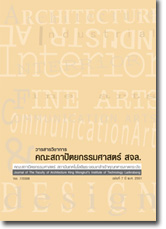Redefining Wang Na Rattanakosin : The History and Conservation of a Royal Thai Palace
Main Article Content
Abstract
Abstract
This purpose of the research is to determine the proper physical characteristics of the area formerly referred to as Bhawornsathanmongkon of Wang Na. Located in Rattanakosin Island. Wang Na is occupied by historical buildings containing artistic and architectural material dating back to the beginning of the Rattanakosin era. Many of these ancient buildings were built more than 200 years ago. In 1926 King Rama VI gave all of the buildings in Wang Na to the authorities for the purpose of creating a museum for the city of Bangkok and to manage the housing and preservation of antiques from all over the country. The use of the original area of Wang Na has undergone many changes. Today the area of Wang Na houses academic and government offices including th National Museum, the National Theatre, the Bhanditpattanasin Institute, Thammasart University and the northern portion of the Phramen grounds.
The change of the Wang Na area from being a palace to being part of the academic section of Thammasart University was carried out without any meaningful conservation plan or proper plan to conserve the history of the area and as a result has been the cause of many problems. These problems have caused disadvantages to the buildings in the area of Rattanakosin in both direct and indirect ways. The government established th Rattanakosin Council to draw up and implement policies to conserve and develop the area. Unfortunately, these policies did not include any effort to conserve Wang Na’s historical value.
Keywords : Conservation, Wang Na, Archeological site, Interpretation Planning
Article Details
This work is licensed under a Creative Commons Attribution-NonCommercial-ShareAlike 4.0 International License.
Copyright Transfer Statement
The copyright of this article is transferred to Journal of The Faculty of Architecture King Mongkut's Institute of Technology Ladkrabang with effect if and when the article is accepted for publication. The copyright transfer covers the exclusive right to reproduce and distribute the article, including reprints, translations, photographic reproductions, electronic form (offline, online) or any other reproductions of similar nature.
The author warrants that this contribution is original and that he/she has full power to make this grant. The author signs for and accepts responsibility for releasing this material on behalf of any and all co-authors.


